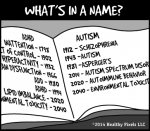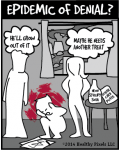The material appearing on HealthyPixels.com is for educational use only. It should not be used as a substitute for professional medical advice, diagnosis or treatment. Healthy Pixels LLC does not endorse and expressly disclaims liability for any product, service, manufacturer mentioned or advertised on this web site.
By Shari Cheves on March 26th, 2014% 
The antioxidant-starved brain
Feeling a little brain fog? Anxiety? Depression? Imbalances and deficiencies in the brain can mess with our thoughts just as they manifest neurological conditions like autism, ADHD, Parkinson’s disease, and Alzheimer’s disease. When we step back and listen for clues, we can hear our cognitive health screaming for attention, namely in . . . → Read More: Autism & ADHD part 4: Food for thought
By Shari Cheves on March 9th, 2014% 
Testing for autism – a dangerous waiting game
Currently, autism can only be diagnosed through careful observation by professional health experts, and we are lacking doctors with experience and training for early screening. At-risk infants and toddlers may be identified early, but most wait many months or years before official diagnosis and treatment . . . → Read More: Autism & ADHD part 3: Testing and diagnosis
By Shari Cheves on March 1st, 2014% 
The CDC reports that up to 1 in 5 children have a mental disorder. While autism is the fastest growing type, ADHD is the most common. According to studies, both autism and attention deficit hyperactivity disorder often involve similar environmental toxins, nutritional deficiencies and therapies. A child’s problems can range from stuttering to social . . . → Read More: Autism & ADHD part 2: Proposed prenatal prevention
By Shari Cheves on December 7th, 2013% 
Highlights
• Autism appears to be a condition that stems from early developmental disturbances in the womb
• Symptoms may be aggravated by exposure to inflammatory substances that are not well tolerated by these individuals
• Autism (ASD) and ADHD (attention-deficit/hyperactivity disorder) tend to co-occur in families and within individuals
• Genetics, exposure to . . . → Read More: Autism & ADHD part 1: Damage to precious cargo
By Shari Cheves on December 17th, 2012% 
I am astounded at how many of us unknowingly suffer from excess histamine. Some of us itch or sneeze while others get headaches, migraines, joint pain, or nausea – within minutes or several hours after exposure! Our “histamine bucket” fills up based on factors such as genetics, allergies, medication, diet, environment, nutritional deficiencies, intestinal damage, . . . → Read More: The many faces of histamine intolerance
By Shari Cheves on August 18th, 2011%
While managing celiac disease for the last three years, I repeatedly hear the same question – “Why?” Millions of stomachs are growling for answers. Sit down for a gourmet dish on an epidemic that hits close to home.
A-B-Celiac
Celiac disease is the presentation of a deeper, self-destructive autoimmune condition experienced by 2 million . . . → Read More: Celiac and bacteria: strange breadfellows
By Shari Cheves on June 24th, 2011% There have been rumors that caffeine in coffee can prevent diabetes. This is a pretty tall order (or should I say venti?) for roasted seeds. With diabetes rates climbing alongside America’s coffee addiction, it seems impossible. After pouring through hundreds of studies on disease risk and prevention, I found one common theme around caffeine: it’s . . . → Read More: Caffeinated coffee: a cup of contradiction
By Shari Cheves on March 15th, 2011% Pain is a language we barely understand. Aches and pains affect our vitality, daily decisions, and outlook on life. We brush them off as old age, stubborn strains or inherited arthritis. Our medicine cabinets feature a smorgasbord of creams and ointments that promise relief, albeit temporary. To reduce or prevent pain in the first place, . . . → Read More: Calcification – the bones of disease?
|
